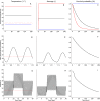Toxicokinetic-Toxicodynamic Model to Assess Thermal Stress
- PMID: 38062939
- PMCID: PMC10734255
- DOI: 10.1021/acs.est.3c05079
Toxicokinetic-Toxicodynamic Model to Assess Thermal Stress
Abstract
Temperature is a crucial environmental factor affecting the distribution and performance of ectothermic organisms. This study introduces a new temperature damage model to interpret their thermal stress. Inspired by the ecotoxicological damage model in the General Unified Threshold model for Survival (GUTS) framework, the temperature damage model assumes that damage depends on the balance between temperature-dependent accumulation and constant repair. Mortality due to temperature stress is driven by the damage level exceeding a threshold. Model calibration showed a good agreement with the measured survival of Gammarus pulex exposed to different constant temperatures. Further, model simulations, including constant temperatures, daily temperature fluctuations, and heatwaves, demonstrated the model's ability to predict temperature effects for various environmental scenarios. With this, the present study contributes to the mechanistic understanding of temperature as a single stressor while facilitating the incorporation of temperature as an additional stressor alongside chemicals in mechanistic multistressor effect models.
Keywords: TK–TD models; environmental risk assessment; temperature stress.
Conflict of interest statement
The authors declare no competing financial interest.
Figures




References
-
- Sunday J. M.; Bates A. E.; Dulvy N. K. Thermal Tolerance and the Global Redistribution of Animals. Nat. Clim. Change 2012, 2 (9), 686–690. 10.1038/nclimate1539. - DOI
-
- Kooijman B.Dynamic Energy Budget Theory for Metabolic Organisation; Cambridge University Press, 2010.
MeSH terms
LinkOut - more resources
Full Text Sources

